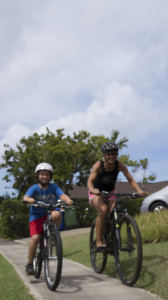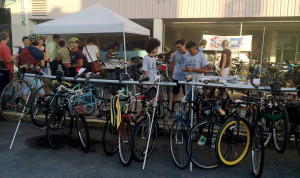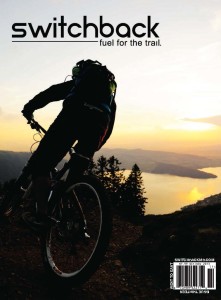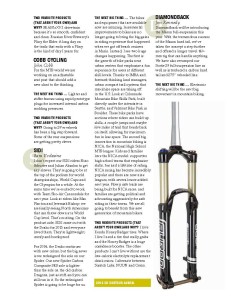In the week after this year’s brutal Honu Half Ironman we sat down with a diverse group of Honu Finishers and asked them “What’s the best advice you can give next year’s racers?” Thanks to Soul Runners for hosting the conversation.
HSM: Hawaii Sport Magazine is compiling tips for having not just a great race, but a great Honu weekend.
I’ll start by passing along something Kelly Sutcliffe told me: When I was training for Honu whenever it was windy I’d cancel my ride and go for a run, and if it was rough I’d swim in the pool. And while I was on the course I realized if anything I should have been doing the exact opposite.
Rebecca Mckee: That’s really good advice.
Angela Kwong: Must also practice grabbing water bottle at aid stations, 2 bottles slipped out of my hands.
Tin Lung Chao: I agree with Angela, practice everything. I saw people drop their gel, one guy drop the entire bottle of his concentrated sport drink mix or whatever he had planned for the entire race, now he has nothing to mix, one guy dropped his spare tube, etc.
Daniel Boatman: I almost hit a rolling CO2 cartridge from the guy passing me. LOL…humans. Noel Mackisoc: Don’t forget your lip balm or sunscreen!
HSM: Noel, do you or anyone else have sunscreen that actually worked that you can recommend? I’ve been seeing some crazy photos of peeling burns on Facebook.
Noel Mackisoc: Planet Sun is what I use. It has been really successful with my races. The trick is to shower when you first get up, dry off, and apply the sunscreen all over, and let it dry. Then put on your tri suit. It works well this way. Also carry a sunscreen chapstick for the run. The run usually will cook your lips if you don’t re-apply.
HSM: Tin Lung Chao, you also used Planet Sun and had a truly impressive peel going. Did you use the same application technique Noel Mackisoc? Noel, it sounds like you’ve found the WAY.
Tin Lung Chao: I apply a thick layer before the race. Very thick, but I did not reapply after the swim exit. Also, I stayed out in the sun after the race till about 5pm, that made it worse, too busy taking photos, ha ha.
HSM: Oh, so now the truth comes out. You were in the sun ALL DAY. Ok, Planet Sun stays on the A list.
Noel Mackisoc: Sorry one more sunscreen comment. For me, the burn happens AFTER the race, when you lay around eating, drinking and talking to a million friends.
HSM: That is a really good point from both of you. And that has to suck for recovery. So the lesson for next year’s race is to think about sun protection when you’re packing clothes for after the race: giant surfer straw hat, long sleeve white tee, whatever it takes.
Noel Mackisoc: yes, I pack a post race bag – at least put on your finisher shirt and a hat!!
Daniel Boatman Wear a hat or visor on the run. Trust me I didn’t and learned. I didn’t burn badly due to SPF 85 but I didn’t need that much sun. Or the sweat-fro hair mess of a lunatic I proudly exhibited on the run and at the finish.
Noel Mackisoc: Hat on the run is good, you can put the cold sponges or ice in there.
Tin Lung Chao: During the run, people get hot, so they pour water, put ice in their tri suit. I did the same, problem was within the first two miles my shoes are all WET!!! Heavy shoes all the way. Need to figure out how to avoid that.
Noel Mackisoc: some people drill holes in the bottom of the shoes to drain water.
HSM: Good point, my K-Swiss have drain holes and I know tri shoes from other brands like Zoot and Saucony have them as well.
HSM: Tin, do you have any non-sunburn related tips for Honu?
Tin Lung Chao: Everyone should know that it is proven that even if you have food poison, diarrhea, vomiting up to the day before race day, you can still do the race and finish it.
HSM: ummmm….is that you with the tummy problems before the race? Holy cow! No bueno!
Tin Lung Chao: That is me, food poisoning from Tuesday till Friday lunch time. I wasn’t going to race, but the diarrhea stopped Friday noon, my coach told me to try race one mile at a time. So I decided to go for it on Saturday.
HSM: Wow amazing, so glad it worked out. Hey at least you had no problem getting down to race weight! I’m terrified to know what you weigh now!
Tin Lung Chao: I lost 10 lbs during my 3-4 months training, and lost about 3-4 lbs during the 3 days leading to the race day due to food poisoning. I am 130 lbs now.
HSM: Tin Lung Chao, we are no longer friends.
Angela Kwong: The main thing I learned is race day is just icing on the cake. The journey to get there, the fun, the training you get to have with great people, the camaraderie between athletes is what makes great memories. I also learned there’s a silver lining to being a slow swimmer, no congestions at T1 and easier to find your bike. I learned not to get discouraged being one of the last swimmers coming out of the water, make it a game to count people you pass on the bike and on the run. Nutrition, the 4th discipline is probably the most important for me, when and what to eat/drink to minimize cramping, fatigue etc. If you don’t have that dialed in you can be great at the other 3 disciplines and you can still have a bad race. And of course what makes it a great weekend is to have lots of pre & post race PAR-TAY.
Noel Mackisoc: Angela, what about the pickle juice?
HSM: Angela preach girlfriend! I agree with every word. Favorite race recovery adult beverage? Does any else make Nuun-tinis?
And yes, WHAT ABOUT THE PICKLE JUICE???
Angela Kwong: Oh yeah…Thanks Noel! Everyone knows I am a cramper but since I discovered pickle juice I cramped a lot less the last few races. When I got off the bike at T2, my quads started to cramp so bad that I could barely put my shoes on, but I didn’t panic, I knew I had my secret potion, I took a couple sips of PJ and within seconds, the cramps went away. I had to periodically take tiny sips throughout the run course to contain my cramps but it sure worked like a charm. I have tried everything these last few years to find a way to minimize my tendency to cramp. Two main things have helped me.
- Pickle Juice (only works when I take tiny sips when I feel cramps coming on, not prophylactically)
- Did a few sweat tests to determine appropriate hydration levels. There two things have helped me minimize cramping substantially.
HSM: Angela Kwong: I’ve never heard of a sweat test. Where did you have it done? And I’m in love with the fact that you sip pickle juice. Do you keep it in a gel flask on your fuel belt? HYSTERICAL
Angela Kwong: I should say a sweat loss test. My coach Eric from Pacific Sports Design makes us weigh ourselves before and after a long bike ride or after our brick workouts to see how much weight we lose. If you lose more than a certain percentage, you are not hydrating enough. After a few sweat loss tests, I finally learned how much to drink during a particular workout. I did not hydrate enough all these years. I thought I did but I didn’t. I drank about four bottles last Saturday during the ride and last year I only drank two. I could feel a huge difference. My bike time was almost 20 minutes faster this year with no cramping.
HSM: Common sense but awesome, thanks Angela! Noel Mackisoc: I think I will try sauerkraut juice next.
Daniel Boatman: Mobility coupled with hydration is up there for pre-event preparation. Massage, body wrench, trigger point, foam roller: use whatever you got. Know your trouble areas. Be loose prior to the start and that will mean less cramping for all.
Tin Lung Chao: Another thing is I saw too many people walking during the run, I never experienced it before, and that made me feel like it is OK to walk, it is normal to walk, so, I join the crowd to walk. Looking back, I should do my own race, just concentrate on what you train for and run, never give up. On the bike, listen to the motorcycle, when you hear it coming, the marshal is near, stay clear of the bike in front of you, look dumb and they will give the red card to the guy next to you, it happened to me three times. LOL.
HSM: Really good point about staying focused on your own race! Rebecca McKee: I want to add two tips
- Even if you get out of the water and your time is totally disappointing, mentally crushing, you have to get on the bike, you can’t stop racing. It’s not one sports, it’s three sports: TRIathlon.
- Also: when you start the run, don’t look at it like you have 13.1 miles, look at it like 1 mile to the next aid station! Then it’s only 1 mile at a time!
Tin Lung Chao: When I got off the bike at about 4 hr 40 minutes, I told myself, I have almost 4 hours to do the run and still make the cut off. BIG MISTAKE, that planted a seed in my mind to go slow and even walk. Well, because of my weak body, my goal is to finish and made the cut off time. But if I didn’t think that way, I could have pushed harder for a better run time.
HSM: Those are really good points about preparation and how you talk to yourself during the race.
Matthew Quinn: PBJ and white rice balls! Mountain Dew, and some GU too. Honey rice crackers, lots of water, some NuuN and post race beer.
Oh if you get the PBJ in your shifter it sucks! And don’t spill Mountain Dew on your front rim, not good for braking!
HSM: Hahahaaaa thanks Matthew Quinn love it!
Angela Kwong: http://www.good.is/posts/how-pickle-juice-changed-the-world-of-sports-food-innovations-from- the-football-field
HSM: Oh hot damn. It’s not just you. It’s a pickle juice revolution. Mixing up the soup mix in top-ramen is almost the same thing, right?
Noel Mackisoc: Scam to sell more pickles HSM: Gotta watch out for that pickle lobby
Rebecca McKee: I have never heard that about the pickle juice, but am intrigued. Peak works with the NHL and we have actually recommend mustard! Most teams keep mustard on the bench @ games for cramping. My Ultraman competitors also use mustard!
HSM: I’ve seen you hand Mike Rouse a hot dog when he’s doing his ultras, so pretty much we have the whole BBQ represented. Do I hear a vote for ketchup?
But seriously, what kind of mustard? And do you eat it or apply it to the affected area?
Melanie Decker Koehl: Buzz Careag is the leader of the mustard movement! :-))) you eat the packets…they’re salty and free :-)))
Angela Kwong: I can only speak for myself, it has worked wonders for me and I have tried everything. I also need to give credit to a sports drink my coach introduced me to called Osmo Nutrition. It has also worked very well.
HSM: I know those guys! I’m sure they’d be stoked to hear that. If your body isn’t working equipment doesn’t really matter, huh?
HSM: I think it’s really important that none of us wanted to talk about equipment, we’re talking about how to keep our bodies functioning and our heads screwed on straight. Conditions at Honu were super tough this year, but it’s never an easy race. Cramping physically or mentally can cost 30 minutes or more, way more than can be gained by a slightly different choice of aero equipment.
So the number one thing you Honu racers can do for next year is take care of your body and keep your positive mental focus.
Thanks everyone for the laughs and the great advice, and see you this weekend on the trails!
Contributors:
Melanie Decker Koehl is an endurance animal, race promoter and Soul Runners Founder
Angela Kwong is a triathlete, multi-time Boston Marathon finisher, rough water swimmer and founding member of Soul Runners
Tin Lung Chao races the Tinman every year. (of course) His goal at age 50 is to set new milestones for himself, so this year he upgraded to Honu, his first half Ironman.
Daniel Boatman is a triathlete, mountainbiker and trail runner who loves team events and is always looking forward to the next adventure.
Noel Mackisoc started racing triathlons in 2009 and immediately became hooked. He’s done 1 Ironman, 4 half Ironmans, and 21 shorter distance triathlons.
Rebecca McKee, coach and founder of Peak Center Alaska, is currently ranked fourth in the world in her age group.
Matthew Quinn is an avid trail runner, triathlete and rough water swimmer.
This story first appeared in the May issue of Hawaii Sport Magazine http://issuu.com/hawaiisportmag/docs/may_2013_web



